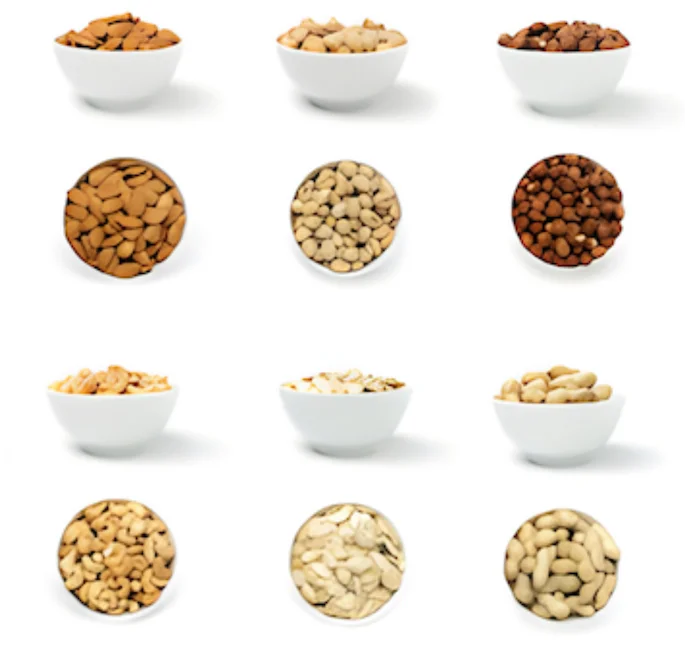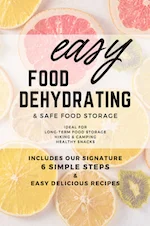Rehydrating Dehydrated Food

Susan Gast | Author, Blogger at Easy Food Dehydrating, Beesville Books, and A New Sober You
When rehydrating dehydrated food, in the images below, you can see the water being absorbed and just how far up the jar the vegetables in the water have risen!
Check Out These "Before" and "After" Photos!
Check Out These
"Before" and "After" Photos!
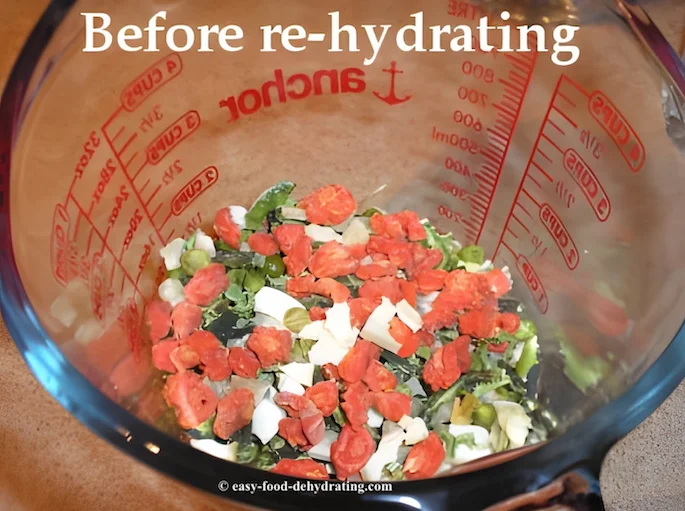
Vegetables Before Rehydrating
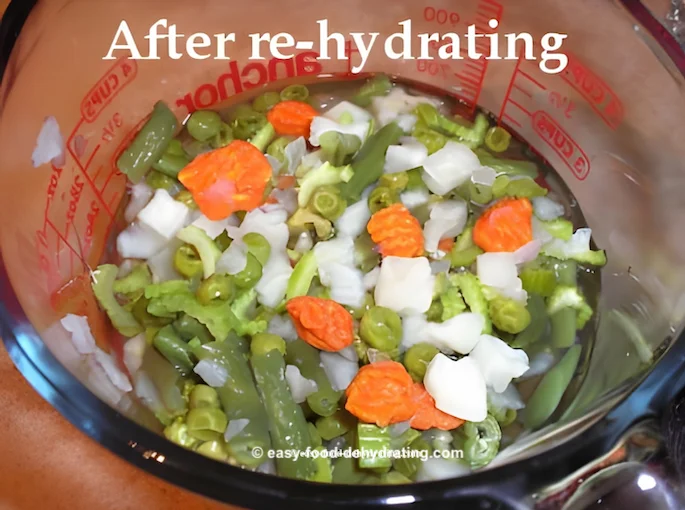
Vegetables After Rehydrating
These dehydrated vegetables are from previously frozen bags of crinkle-cut carrots, peas, and green beans. There are also some Ore-Ida Hash Brown potatoes in there—along with dehydrated fresh onion, celery, and elephant garlic!
Note: You now have the humble/great beginnings of a very tasty Vegetable Soup.
That's the magic of rehydrating food! It's fun to watch it plump back up!
Frequently Asked Questions:
Rehydrating food? (Yep, top question, not surprisingly!)
Rehydrating food? (Yep, top question, not surprisingly!)
The key to rehydrating dehydrated foods is allowing enough time and the right technique based on what you're rehydrating. Some options for rehydration methods:
- Soak in warm or hot water: For dehydrated veggies, fruits, beans, herbs, and more, cover with warm or hot water and allow to soak 30-90 minutes until desired plumpness. Save the soaking liquid for added nutrients in recipes!
- Cook in broths, sauces, or dishes: Soups, stews, casseroles, and tomato-based dishes are flavorful, and they're ideal for adding dehydrated vegetables as they simmer. Add the dehydrated items directly in the pot.
- Melt fat: For dehydrated mushroom slices or herbs like parsley and chives, melt some butter or coconut oil, and sauté a minute or two over low heat to slowly allow the water-soluble flavors and textures to restore before adding to dishes.
The key is not overcooking after rehydrating, as most dehydrated food products only need a brief return to moisture, not excessive additional cooking. Pay attention while rehydrating and as you use them.
Hopefully, these tips give you a helpful starting point for ways to efficiently rehydrate all your dehydrated foods!
And, the second top question: Can you rehydrate dehydrated food?
And, the second top question: Can you rehydrate dehydrated food?
And the answer to that is in the response to the first question!
How to rehydrate dehydrated food?
How to rehydrate dehydrated food?
This is a top search query, and the answer to it is on this page you're reading.
How much water to use to rehydrate food?
How much water to use to rehydrate food?
As shown further down the page, you'll see I use a ratio of 2:1; two parts water to one part food. It's not set in stone; it takes as much water as necessary. When your foods are "plump enough," drain off the excess water and you're good to go.
Rehydrating Dehydrated Food
This is the AMAZING PART! Hopefully, you've learned a lot from our site about how to dehydrate your foods, so now it's time to put the water back in and rehydrate dehydrated food!

Make Sure To Add Enough Water!
For a cupful of dehydrated veggies, for instance, I'll add water to the 2-cup mark in a glass measuring jug.
Add twice the amount of water to the amount of food you are rehydrating.
It's really only a case of making sure there's enough water for the foods to drink up while rehydrating food.
Keep your eye on the food. Add more water if it looks like it'll dry up before your foods are nice and plump again!
Should I Use Hot or Cold Water?
I use hot (boiling) water for rehydrating food when I'm making a recipe that calls for hot 'stock' because my bouillon dissolves better in just-boiled water—but if you know it'll be sitting around a while before you get to use it, then cold (clean) water works fine.
I MUST make an important point here: If you are rehydrating food in hot water, please make sure to BRING IT BACK TO A BOIL while you're preparing your recipe.
You don't want to have food sitting around in warm water without boiling it again—be safe—don't let any airborne germs get a chance to fester in "warm" food prior to eating it!
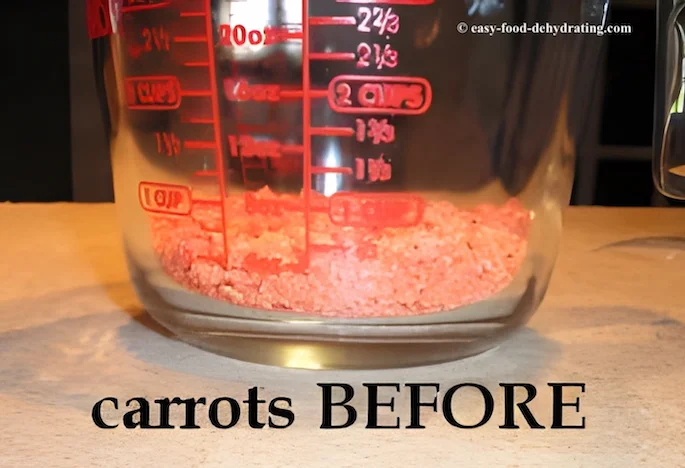
Carrots Before Rehydrating

Carrots After Rehydrating
It takes about an hour for small veggies to plump back up in the water; the larger veggies take longer, about two hours.
Also, note that you may want to cook your rehydrated veggies a little longer than usual... it helps make the vegetables taste like whole vegetables again.
Water Quality Counts when Rehydrating Dehydrated Food
Remember, the quality of the water you use while rehydrating dehydrated food IS important, as the water is absorbed by the foods that you are going to eat rehydrated again—so don't skimp here by using nasty water!
By nasty, you know what I mean! If you wouldn't drink it, don't use it! Make sure it's good, clean, drinking water.
Grind It Up!
It's not always necessary to rehydrate your foods. Grind up some of your dehydrated garlic to make garlic powder, and grind up some dehydrated onions too for onion powder!
Don’t forget dehydrated celery for celery powder (add a little salt to create celery salt).
If you're making a soup where the vegetables aren't sautéed in olive oil at the start of the recipe, then go ahead and add them to the water (or soup stock or soup base according to the recipe) in their dehydrated form!
They plump right up in the
water/stock base if you let them sit and cook long enough! Shredded dehydrated cabbage is another vegetable that is great tossed in soup while you're making the soup in the pan!
What About Nutrients?
Melba, a good friend of mine, asked me if dehydrated foods lose their nutritional value and how do they really taste when rehydrated.
Excellent questions Melba! I assured her they keep much of their nutritional value because all that's been taken out is their water content during the dehydration process... (but like ALL fruits and vegetables, when overcooked, they WILL lose nutrients!)
What About the Taste?
I admit my first effort at rehydrating carrots yielded somewhat spongy carrots, but when I cooked them a little longer, they were fine. For the record, they were whole baby carrots and that might have had something to do with the sponginess (being whole and not sliced).
My sliced carrots rehydrated perfectly! All the other vegetables came back to life when added to water and it's really quite amazing to see! My favorites are peas and celery! The grated carrots in the above photos were for Deb's Delectable Carrot Cake—check it out, it's delectable, alright!
Take a look at Preparedness Advice—they have a good chart on how much water to use when rehydrating your dehydrated foods.
What's a "Normal Portion Size?"
Audrey wrote in to ask, "Susan, what's a normal portion size of dehydrated carrots?"
Great question Audrey! First, thanks for taking the time to write in.
For a personal portion of carrots - using dehydrated carrots - I'd say a "couple of handfuls" would be enough. Carrots shrink down to at least half their normal size, so just look at a couple of handfuls (assuming you don't have massive hands, LOL) and imagine those handfuls to be double that when they're rehydrated.
I hope this helps, and thanks for asking!
Lori's "Faster Pasta Prep"
Read how Lori's rehydrated pasta turned out –
and how it could affect your bottom line!
Lori's "Faster Pasta Prep"
Read how
Lori's rehydrated pasta
turned out – and
how it could affect
your bottom line!
(and I bet you all said, "Lori's Fasta Pasta Prep" like I said to myself!)
Thanks for taking the time to read rehydrating dehydrated food. If you have any questions, write to me here!
Don't forget to grab your free Six Simple Steps eBook! It’s packed with tips for dehydrating everything from fruits and veggies to dog treats. Get it here.
Before You Go...
If you like the content, please give me some love by clicking on the 🩷 in the lower right hand corner (on just about all my pages). This signals to me that you find it enjoyable and useful. Thank you so much!




